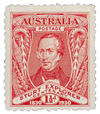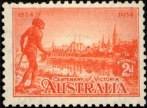History
Timeline results for
Found 1169 results for your search. Showing page 9 of 59.
1925
-
Glen Crouch is the first Aboriginal footballer to tour overseas, playing 11 games for Queensland in a New Zealand tour.
-
Australian Aboriginal Progressive Association is formed in Sydney to oppose New South Wales Aborigines Protection Board. Its inaugural president is Fred Maynard.
1926
-
Following the killing of a European in Dala, Western Australia, 11 Aboriginal people are murdered in police custody; no prosecutions follow.
1927
-
Federal law for family endowment excludes Aboriginal people and instead payments go to the Aborigines Protection Board. Aboriginal people are denied maternity allowance and old age pension.
-
Aboriginal people are banned from central Perth until 1948.
1928
-
Conniston Massacre in the Northern Territory. Europeans shoot 32 Aboriginal people after a European dingo trapper and a station owner are attacked by them.
A court of inquiry rules the Europeans’ action ‘justified’. Aboriginal people are refused legal aid by the federal government. -
Aboriginal activist and toymaker Anthony Martin Fernando (1864 - 1949) is picketing Australia House in London. Pinned to his coat
are scores of small, white, toy skeletons and he’s wearing a placard proclaiming: ‘This is all Australia has left of my people’.
1929
-
Queensland Protector of Aborigines recommends to the federal government that Aboriginal people be assimilated where they are in contact with European society and that inviolable reserves be established for tribal people.
-
Aboriginal athlete Lynch Cooper is named World Professional Sprint Champion after winning the 1928 Stawell Gift and the 1929 World Sprint.
1930
-
The Tweed Heads All Blacks and the Redfern All Blacks are both in operation as early as 1930.
-
Victorian Yorta Yorta man William Cooper petitions the King to have an Aboriginal representative in the federal House of Representatives, the main chamber of the national Australian parliament. A similar attempt is made in NSW. They are unsuccessful.
-

1930: Can you find all elements in the stamp? The first stamp of Australia showing a reference to Aboriginal culture celebrates the centenary of Exploration of Murray River (1½d red and 3d blue). It shows a boomerang, a coolamon, two spear heads and Lyre bird tail feathers.
1933
-
Yorta Yorta man William Cooper establishes the Australian Aborigines' League in Melbourne together with Margaret Tucker, Eric Onus, Anna and Caleb Morgan, and Shadrach James. Cooper is secretary of the League which campaigns for the repeal of discriminatory legislation and First Nations representation in the Australian Parliament.
1934
-
The Arnhem Land Reserve is declared.
-

One of the earliest Australian stamps with a reference to Aboriginal culture. The 1934 stamp issue shows an Aboriginal man with spears walking towards a river that separates him from the town beyond, almost as if to show the contrast between pre and post invasion conditions. There were three denominations to the set.
1935
-
The Methodist Overseas Mission establishes Yirrkala, an Aboriginal community on the Gove Peninsula, Northern Territory. It was later taken over by the United Church in North Australia.
-
The introduction of the Infants Welfare Act (Tasmania) is used to remove Indigenous children on Cape Barren Island from their families. From 1928 until 1980 the head teacher on Cape Barren is appointed as a special constable with the powers and responsibilities of a police constable, including the power to remove a child for neglect under child welfare legislation.
1936
-
Western Australia Aborigines Act is amended to permit Aboriginal people to be taken into custody without trial or appeal and to prevent them from entering prescribed towns without a permit.
-
Torres Strait Islanders unite in the Maritime Strike, protesting against poor working conditions of pearl divers and for the Islander’s right to determine how they spend their wages and to control their own affairs. The strike is about equality and autonomy. Islanders used ingenious methods to organise the strike to avoid detection, such as submerging messages for pearl divers or talking in language. The strike lasted 9 months and eventually led to the Queensland government passing the Torres Strait Islander Act 1937 giving legal recognition to Torres Strait Islanders as a separate Indigenous people.
1937
-
Arthur 'Stoker' Currie is the first Aboriginal player to make the Country side which beats City. He plays bare-footed for Tweed Heads All Blacks. His grandson, Tony, plays for Australia.

